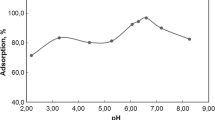Abstract
The uranium sorption from diluted aqueous solution onto lead hydroxyapatite was studied by using a batch-mode technique and the fluorimetric determination of uranium mass concentration. Partially crystallised lead hydroxyapatite [Pb10(PO4)6(OH)2] was obtained by direct precipitation and mild heating. This material presents very high specific surface, which is the key factor in the sorption of uranium from diluted solution. This material has a high ability to remove uranium (K d,max from 5,661 to 18,833 ml/g, at 4 and 60 °C, respectively) in the chosen setup conditions (initial concentration of uranium 5 × 10−6 M and pH 5.65).





Similar content being viewed by others
Abbreviations
- PbHAp:
-
Lead hydroxyapatite
- ppm:
-
Part per million
References
Rathore DPS (2008) Advances in technologies for the measurement of uranium in diverse matrices. Talanta 77(1):9–20
Sachs S, Bernhart G (2011) Influence of humic acids on the actinide migration in the environment: suitable humic acid model substances and their application in studies with uranium—a review. J Radioanal Nucl Chem 290(1):17–29
Humelnicu D, Drochioiu G, Sturza MI, Cecal A, Popa K (2006) Kinetic and thermodynamic aspects of U(VI) and Th(IV) sorption on a zeolitic volcanic tuff. J Radioanal Nucl Chem 270(3):637–640
Tykva R, Salahel Din K, Pavel CC, Cecal A, Popa K (2009) Contribution to the external surface of a titanium-rich sand (Abou-Khashaba, Egypt) in the uranium uptake process. J Radioanal Nucl Chem 279(3):811–816
Pavel CC, Walter M, Popa K (2008) The improuvement of retention capacity of ETS-10 towards uranyl ions by porosity modification and their immobilization into a titanosilicate matrix. J Mater Chem 18(27):3342–3346
Popa K, Pavel CC (2012) Radioactive wastewaters purification using titanosilicates materials: state of the art and perspectives. Desalination 293:78–86
Jeanjean J, Rouchaud JC, Tran L, Fedoroff M (1995) Sorption of uranium and other heavy metals on hydroxyapatite. J Radioanal Nucl Chem 201(6):529–539
Ulusoy U, Akkaya R (2009) Adsorptive features of polyacrylamide-apatite composite for Pb2+, UO2 2+ and Th4+. J Hazard Mater 163(1):98–108
Krestou A, Xenidis A, Panias D (2004) Mechanism of aqueous uranium(VI) uptake by hydroxyapatite. Miner Eng 17(3):373–381
Simon FG, Biermann V, Segebade C, Hedrich M (2004) Behaviour of uranium in hydroxyapatite-bearing permeable reactive barriers: investigation using 237U as a radiotracer. Sci Total Environ 236(1–3):249–256
Galambos M, Suchanek P, Rosskopfova O (2012) Sorption of anthropogenic radionuclides on natural and synthetic inorganic sorbents. J Radioanal Nucl Chem 293(2):613–633
Chattanathan SA, Clement TP, Kanel SR, Barnett MO, Chatakandi N (2013) Remediation of uranium-contaminated groundwater by sorption onto hydroxyapatite derived from catfish bones. Water Air Soil Pollut 224:1429–1437
Rodriguez-Carvajal J (2001) FULLPROF.2k: rietveld, profile matching and integrated intensity refinement of X-ray and neutron data, V 1.9c. Laboratoire Léon Brillouin, CEA, Saclay
M 01–15-2005 (2009) Water quality. Method for the determination of mass concentration of uranium in the samples of natural, drinking and waste water with the use of liquid analyzer Fluorat-02-2M. Lumex Ltd., Saint Petersburg
Negas T, Roth RS (1968) High temperature dehydroxylation of apatitic phosphates. J Res Nat Bur Stand 72A:783–787
Blakeslee KC, Condrate RA (1977) Vibrational spectra of hydroxylthermally prepared hydroxyapatites. J Am Ceram Soc 54(11):559–563
Kim JY, Hunter BA, Fenton RR, Kennedy BJ (1997) Neutron powder diffraction study of lead hydroxyapatite. Aust J Chem 50(11):1061–1066
White TJ, ZhiLi D (2003) Structural deviation and crystal chemistry of apatites. Acta Cryst B59:1–16
Yusan S, Gok C, Erenturk S, Aytas S (2012) Adsorptive removal of thorium(IV) using calcined and flux calcined diatomite from Turkey: evaluation of equilibrium, kinetic and thermodynamic data. Appl Clay Sci 67–68:106–116
Dong HY, Liu ZJ, Li YY, Chen L, Zhang ZC (2012) Effect of pH, ionic strength, foreign ions, fulvic acid and temperature on 109Cd(II) sorption to γ-Al2O3. J Radioanal Nucl Chem 292(2):619–627
Huang Y, Wang H, Gong S (2012) Sorption behavior of hydroxyapatite for 109Cd(II) as a function of environmental conditions. J Radioanal Nucl Chem 292(2):545–553
Chen SW, Guo BL, Wang YL, Li Y, Song LJ (2013) Study of sorption of U(VI) onto ordered mesoporous silicas. J Radioanal Nucl Chem 295(2):1435–1442
Lagergren S (1898) Zur teorie der sogenannten adsorption gelöster stoffe. Kungliga Sveska Vetenskapsakademiens Handlingar 24(4):1–39
Pavel CC, Popa K, Bilba N, Cecal A, Cozma DG, Pui A (2003) Study of sorption of some radiocations on microporous titanosilicate ETS-10. J Radioanal Nucl Chem 258(2):243–248
Popa K, Pavel CC, Bilba N, Cecal A (2006) Purification of waste waters containing 60Co2+, 115mCd2+ and 203Hg2+ radioactive ions by ETS-4 microporous titanosilicate. J Radioanal Nucl Chem 269(1):155–160
Pavel CC, Walter M, Popa K (2011) Contrasting immobilization behaviour of Cs+ and Sr2+ cations into a titanosilicate matrix. J Mater Chem 21(11):3831–3837
Borcia C, Popa K, Pavel CC, Dascalu A, Vitelaru C, Apetrachioaei BA (2011) Sorption of thallous ion from acidic aqueous solutions onto as-made and modified ETS-10. J Radioanal Nucl Chem 288(1):25–30
Author information
Authors and Affiliations
Corresponding author
Rights and permissions
About this article
Cite this article
Popa, K. Sorption of uranium on lead hydroxyapatite. J Radioanal Nucl Chem 298, 1527–1532 (2013). https://doi.org/10.1007/s10967-013-2551-6
Received:
Published:
Issue Date:
DOI: https://doi.org/10.1007/s10967-013-2551-6




